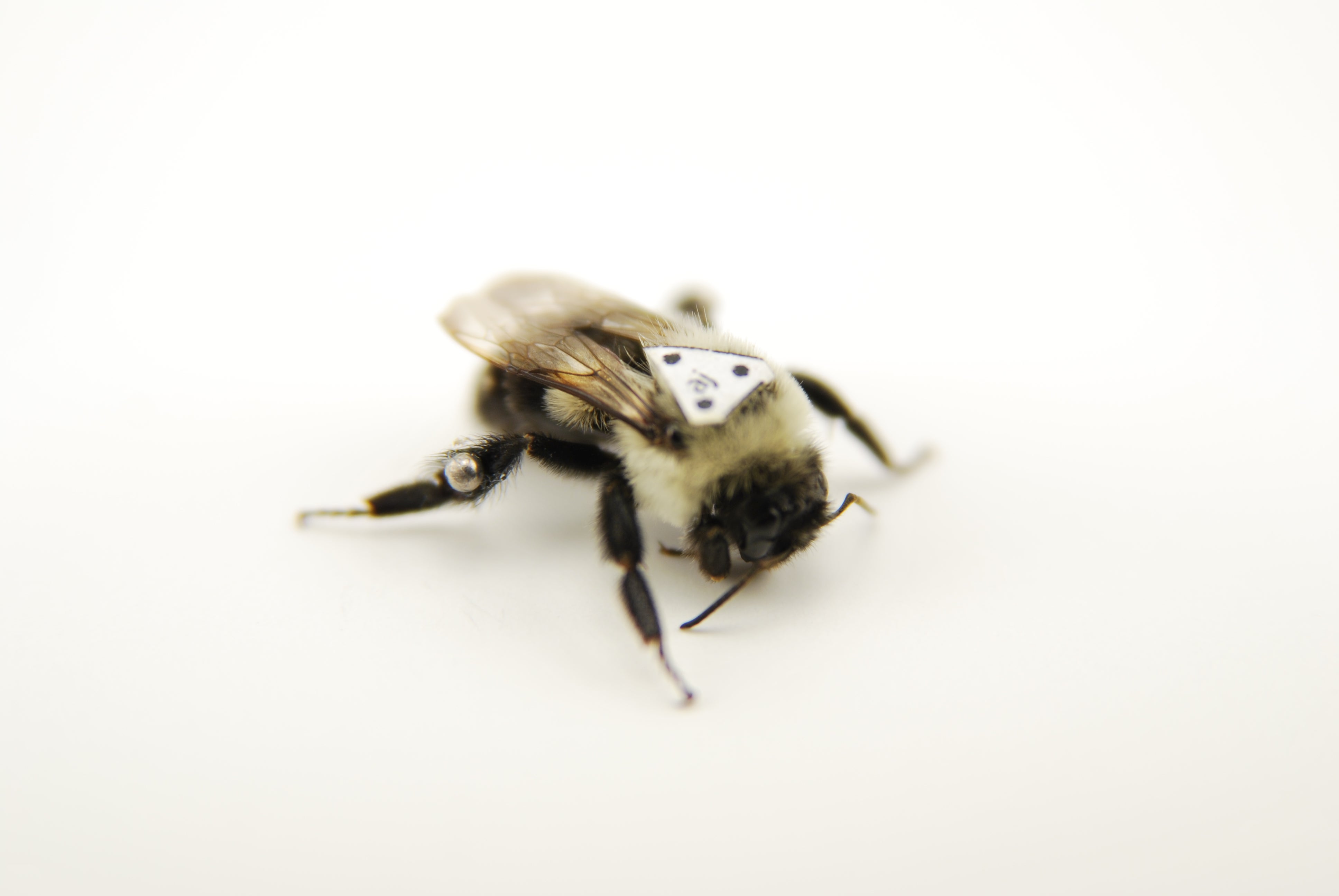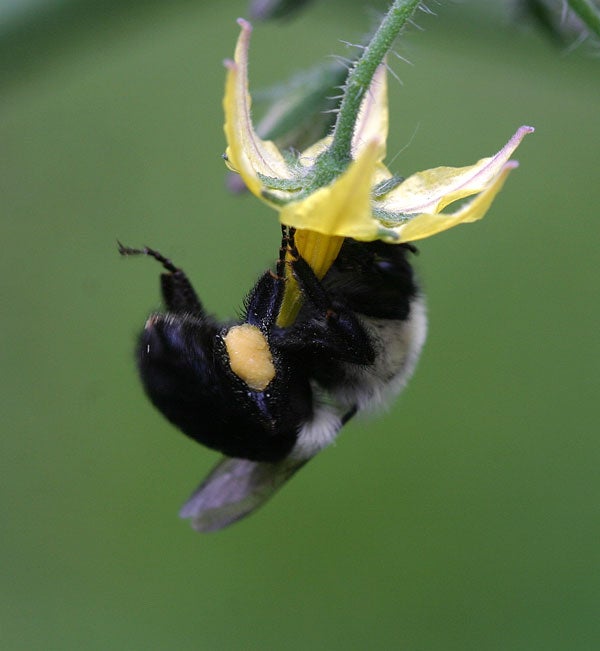 Another area of research in the lab concerns a variety of complex behaviors displayed by flying insects. Some of these behaviors occur during flight, while others occur while insects hunt, gather resources, or care for young. I am particularly interested in complex flight behaviors that are linked to fitness, such as aerial predation or efficient foraging for floral resources. My first NSF grant focused on the behavior and flight performance of dragonflies during aerial predation. This work was performed in an outdoor, semi-natural enclosure, and we used a variety of live, freely flying prey whose flight behavior and performance ended up providing as many novel insights as the dragonflies themselves. We found differences in the flight performance and predation strategies of several species of dragonflies chasing different types of prey, and showed that wing damage reduces peak acceleration and predation success in dragonflies. More recently, we have examined interactions between damselflies and their small, aerial prey in a lab enclosure, asking whether the presence and type of wind affects this interaction.
Another area of research in the lab concerns a variety of complex behaviors displayed by flying insects. Some of these behaviors occur during flight, while others occur while insects hunt, gather resources, or care for young. I am particularly interested in complex flight behaviors that are linked to fitness, such as aerial predation or efficient foraging for floral resources. My first NSF grant focused on the behavior and flight performance of dragonflies during aerial predation. This work was performed in an outdoor, semi-natural enclosure, and we used a variety of live, freely flying prey whose flight behavior and performance ended up providing as many novel insights as the dragonflies themselves. We found differences in the flight performance and predation strategies of several species of dragonflies chasing different types of prey, and showed that wing damage reduces peak acceleration and predation success in dragonflies. More recently, we have examined interactions between damselflies and their small, aerial prey in a lab enclosure, asking whether the presence and type of wind affects this interaction.
In eusocial insects such as bumblebees, fitness of the hive as a whole depends less on the peak flight performance of individuals (as in dragonflies), and more on the ability of workers to forage efficiently over long periods of time, collecting nectar and pollen, and returning to the nest with heavy loads.  Optimal foraging models typically assert that the cost of loaded flight determines how far bees fly and how much nectar or pollen they collect, and assume that flight costs increase linearly with load size, as in airplanes. We recently performed a respirometry study in which we measured the carbon dioxide output of individual bees and varied their load sizes, to determine how loading affects the metabolic cost of flight. Surprisingly, we found that flight costs do not increase linearly with load size – rather, bees become more efficient per unit of added weight as they are more heavily loaded, and they display greater flight efficiency when fatigued than when well rested. Both outcomes are related to our finding that metabolic rate is strongly tied to flapping frequency, which is not prescribed by load size, but which bees can alter to adjust the metabolic cost of flight in a given situation, by shifting to alternative force production mechanisms. In addition to examining the cost of loaded flight, we have studied how the location of loads carried on the body (nectar within the honey crop vs. pollen on the hind legs) affects flight stability and maneuverability. We found that carrying pollen on the legs increases stability in unsteady winds but impairs maneuverability, while carrying nectar within the body has the opposite effect.
Optimal foraging models typically assert that the cost of loaded flight determines how far bees fly and how much nectar or pollen they collect, and assume that flight costs increase linearly with load size, as in airplanes. We recently performed a respirometry study in which we measured the carbon dioxide output of individual bees and varied their load sizes, to determine how loading affects the metabolic cost of flight. Surprisingly, we found that flight costs do not increase linearly with load size – rather, bees become more efficient per unit of added weight as they are more heavily loaded, and they display greater flight efficiency when fatigued than when well rested. Both outcomes are related to our finding that metabolic rate is strongly tied to flapping frequency, which is not prescribed by load size, but which bees can alter to adjust the metabolic cost of flight in a given situation, by shifting to alternative force production mechanisms. In addition to examining the cost of loaded flight, we have studied how the location of loads carried on the body (nectar within the honey crop vs. pollen on the hind legs) affects flight stability and maneuverability. We found that carrying pollen on the legs increases stability in unsteady winds but impairs maneuverability, while carrying nectar within the body has the opposite effect.
 Before facing the challenge of flying with loads of nectar or pollen, bees must collect these resources – a difficult task when pollen is enclosed within poricidal anthers, which release pollen only when vibrated at high frequencies. A former graduate student in the lab, Callin Switzer, explored buzz pollination, a non-flight behavior in which the asynchronous flight muscles are co-opted to buzz flowers at high frequency without moving the wings. He examined mechanical variability, modes of learning, and the effects of neonicotinoid pesticides on this behavior. Another former student, Jake Peters, studied collective hive ventilation in honeybees – another non-flight behavior that involves co-opting the flight machinery. During this behavior, numerous workers arrange themselves at the hive entrance and flap their wings without lifting off, driving one-way flow to cool the hive and remove carbon dioxide.
Before facing the challenge of flying with loads of nectar or pollen, bees must collect these resources – a difficult task when pollen is enclosed within poricidal anthers, which release pollen only when vibrated at high frequencies. A former graduate student in the lab, Callin Switzer, explored buzz pollination, a non-flight behavior in which the asynchronous flight muscles are co-opted to buzz flowers at high frequency without moving the wings. He examined mechanical variability, modes of learning, and the effects of neonicotinoid pesticides on this behavior. Another former student, Jake Peters, studied collective hive ventilation in honeybees – another non-flight behavior that involves co-opting the flight machinery. During this behavior, numerous workers arrange themselves at the hive entrance and flap their wings without lifting off, driving one-way flow to cool the hive and remove carbon dioxide.
![]() Finally, our efforts to link foraging behavior to external flow conditions led us to also examine task allocation and behavior within the hive. In bumblebees, a handful of foragers supply most of the nectar and pollen for hundreds of bees within the hive. Former student James Crall developed a powerful, inexpensive method of automatically tracking individual bees (BEEtags), which includes open-access code to create unique QR-code tags in Matlab and automatically locate and identify any tags within an image. This allowed him to determine how bees re-allocate labor when a key forager is lost, and how neonicotinoid pesticides impair social interactions, activity levels, and thermoregulatory behavior in hives. The development of these BEEtags, as well as our application of deep learning methods for high-throughput digitization and data association algorithms to resolve simultaneous flight trajectories, has opened up a range of new experimental possibilities that will allow us to explore novel questions about the biomechanics and behavior of flying insects.
Finally, our efforts to link foraging behavior to external flow conditions led us to also examine task allocation and behavior within the hive. In bumblebees, a handful of foragers supply most of the nectar and pollen for hundreds of bees within the hive. Former student James Crall developed a powerful, inexpensive method of automatically tracking individual bees (BEEtags), which includes open-access code to create unique QR-code tags in Matlab and automatically locate and identify any tags within an image. This allowed him to determine how bees re-allocate labor when a key forager is lost, and how neonicotinoid pesticides impair social interactions, activity levels, and thermoregulatory behavior in hives. The development of these BEEtags, as well as our application of deep learning methods for high-throughput digitization and data association algorithms to resolve simultaneous flight trajectories, has opened up a range of new experimental possibilities that will allow us to explore novel questions about the biomechanics and behavior of flying insects.